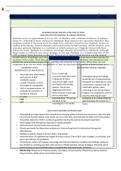Samenvatting
Summary Basic Cell & Molecular Biology
- Instelling
- Rijksuniversiteit Groningen (RuG)
Summary of the lectures of Basic Cell & Molecular biology. This is a course given in the first year of the study biology at the university of Groningen. By being able to memorize the text and especially the pictures in this document, I was able to get a good grade for my exam.
[Meer zien]














